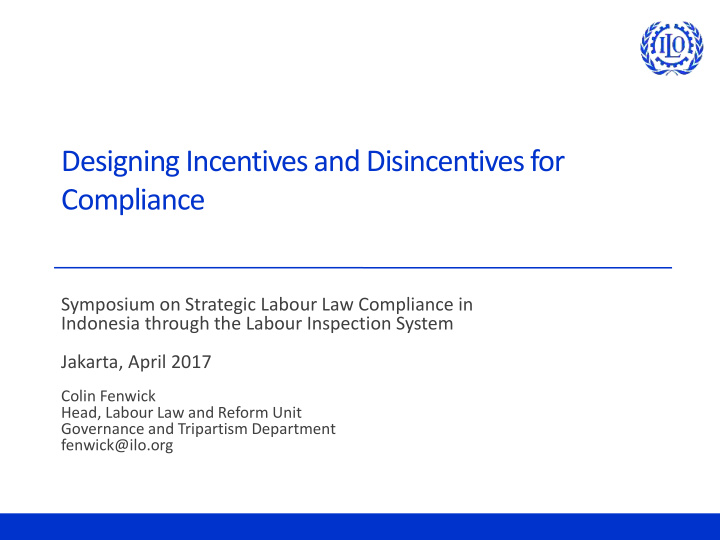



Designing Incentives and Disincentives for Compliance Symposium on Strategic Labour Law Compliance in Indonesia through the Labour Inspection System Jakarta, April 2017 Colin Fenwick Head, Labour Law and Reform Unit Governance and Tripartism Department fenwick@ilo.org
Law, regulation and compliance • Coerce or coordinate? • “An effective system of legal compliance based on sanctions is . . . quite difficult to achieve. It requires significant investment in capacity and infrastructure and careful analysis of the types of incentives most likely to work.” • “people obey laws for reasons other than fear of punishment when they believe the laws are the product of a system they believe to be legitimate.” • World Bank, Governance and the Law (World Development Report 2017), pp 88, 90.
Design choices: the case of OSH standards • Specific or general? • External or internal? “We need a more effectively self- regulating system.” ( Robens) • Prescription or performance?
Design principles to promote compliance • Law design must consider both : • Normative content; and • How best to promote compliance, including through enforcement • Design and implementation must be participatory • Both design and implementation should be specifically targeted to policy goals and for effective regulation • Adapted from: Fenwick, et al, Labour and Labour Related Laws in Micro- and Small Enterprises: Innovative Regulatory Approaches (ILO/SEED Working Paper No. 81, 2007)
(Responsive) Labour Regulation Pyramid Punitive sanctions Tailored sanctions Warnings Monitoring Compliance & Coordination of State and Private Actors Information, Education and Incentives for Compliance Source: Fenwick, et al, Labour and Labour Related Laws in Micro- and Small Enterprises: Innovative Regulatory Approaches (ILO/SEED Working Paper No. 81, 2007)
Technical implications • Rules that are easy : to understand, comply with, enforce • Tailored rules for national context (capacity, informality, etc) • Rules that promote compliance by: • Empowering the labour administration to reach out Empowering other actors to participate, perhaps to enforce • Effective dispute resolution institutions are fundamental
Examples of incentives • Risk-rating of social security or insurance contributions • Publication – positive or negative • Financial benefits • Tax reductions • Access to credit • Access to government programmes and contracts • Certification to carry out self-assessment • Access to training
Recommend
More recommend